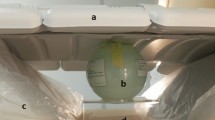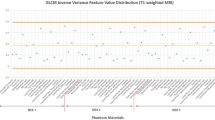Abstract
The purpose of this study was to compare several quantitative imaging parameters for mobile magnetic resonance imaging (MRI) to stationary MRI. The acquisition conditions for MRI were as follows: the American College of Radiology (ACR) phantom was used as the essential part of MRI quality control (QC) protocols, and seven tests were quantitatively evaluated: geometric accuracy, high-contrast resolution, slice thickness accuracy, slice position accuracy, image intensity uniformity, percent signal ghosting, and low-contrast object detectability. We evaluated image quality using digital analysis methods with the new percent integral uniformity (PIU) method. The results indicate that the mobile MRI was degraded with significant differences in geometric accuracy (p = 0.021), image intensity uniformity (PIU p = 0.248, New PIU p = 0.043), and high-contrast spatial resolution of 0.9 mm (p = 0.019). In particular, image intensity uniformity was significantly different between the two different MRI system based on the new PIU (p = 0.043), but was not on the conventional PIU (p = 0.248). Our methods suggest that mobile MRI is more easily exposed to external high-frequency noise than stationary MRI. In conclusion, when reading images with mobile MRI, it is important to pay attention to geometric accuracy and high-contrast resolution, which require shielding against external high-frequency signals.










Similar content being viewed by others
References
WH Bence Coachworks, IM I & TP, Society & College of Radiographers, Jun (2010). https://search.proquest.com
American of College Radiology, Phantom test guidance for the ACR MRI accreditation program (American of College Radiology, 2005)
Z. Mansour, A. Mokhtar, A. Sarhan et al., Egyptian Soc Radiol Nucl Med. 47, 1665 (2016)
P.F. Christopher, M.K. Deirdre, A.E. Heidi et al., Med Devieces 7, 363 (2014)
J.W. Lee, K.J. Ahn, S.K. Lee et al., J. Korean Rad Soc. 54, 47 (2006)
H.M. Etman, A. Mokhtar, M.I. Abd-Elhamid et al., J. Egypt Radiol and Nucl Med 48, 153 (2016)
C.C. Chen, Y.L. Wan et al., J. Digit imaging 17, 279 (2005)
S. Noguchi, A. Ishiyama, IEEE Trans 33, 1904 (1997)
S.E. Jung, J. Korean Med Assoc 58, 1112 (2015)
W.T. Lim, J. Indian Sci Tech 9, 1 (2016)
F.G. Shellock, Health effects saf (CRC Press, Florida, 2001)
R.J. Cortes, M.G. Sanchez, L.G. Lope et al., J Eur Med Phys. 32, 219 (2016)
K. Doris, N. Mait, Proc Estonian Acad Sci. 63, 328 (2014)
M. Adjeiwaah, A. Garpebring, T. Nyholm, Phys Imaging Radiat Oncol. 13, 21 (2020)
M.J. Bronskill, P.L. Carson, S. Einstein et al. AAPM Report No. 20: Site Planning For Magnetic Resonance Imaging Systems. New York, NY: American Institute of Physics (1986).
B.I. Lee, Nucl Med Mol Imaging 42, 137 (2008)
J. Weibler, L.R. Enclosures. Properties of Metals used for RF shielding. EMC Test and Design. (1993) Dec:100.
Frank G. Shellock. Ph.D, CRC press, 144 (2011).
T.M. Ihalainen, N.T. Lönnroth, J.I. Peltonen et al., Acta Oncolo 50, 966 (2011)
Author information
Authors and Affiliations
Corresponding author
Additional information
Publisher's Note
Springer Nature remains neutral with regard to jurisdictional claims in published maps and institutional affiliations.
*.
Rights and permissions
Springer Nature or its licensor holds exclusive rights to this article under a publishing agreement with the author(s) or other rightsholder(s); author self-archiving of the accepted manuscript version of this article is solely governed by the terms of such publishing agreement and applicable law.
About this article
Cite this article
Hong, HL., Seoung, YH. Comparison of quantitative imaging parameters between two different types of stationary and mobile magnetic resonance imaging. J. Korean Phys. Soc. 81, 1146–1156 (2022). https://doi.org/10.1007/s40042-022-00566-z
Received:
Revised:
Accepted:
Published:
Issue Date:
DOI: https://doi.org/10.1007/s40042-022-00566-z




